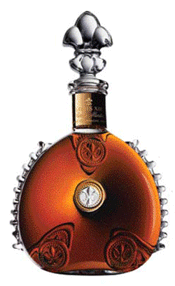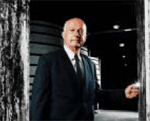|
Spindly, curved vines crawl out from a frosty ground dotted
with
yellow, post-harvest leaves while autumnal light drizzles through
thinning trees and out across endless French vineyards. The
wind is
cold and sharp, yet everything about Cognac’s air, smell,
light and temperature make it perfect for tasting Rémy
Martin Louis XIII.
Aside from learning about this spirit’s double distillation
process and the company history of Rémy Martin, I was
made fully aware during my two days in the region of the importance
of Louis XIII, the most illustrious, expensive and – as
I was fortunate to discover – beautiful of Rémy
Martin Cognacs, It is served in just 13 exclusive locations
around the world, and the only one in the UK is in London’s
Sanderson hotel. Others include The Beverly Hills Hotel in LA,
the Burj Al Arab in Dubai and the Peninsula in Hong Kong. After
winning an award at the 1900 Paris Universal Exhibition, it
was served to the British monarch King George VI at Versailles
in 1938, while Winston Churchill reportedly toasted his electoral
win of 1951 with it.
Contemporary fans of the brandy, meanwhile, include the King
of
Cambodia, hip-hop star P Diddy, opera singer Plácido
Domingo
and boxing icon Oscar de la Hoya.
Generation after generation Named after a French king who ruled
in the early 17th century, Louis XIII was created in 1874 when
Paul-Emile Rémy Martin I blended some very old eaux-de-vie
in a decanter. The resulting drink is, today, a blend of 1200
eaux-de-vie aged between 40 and 100 years old, all produced
from Grande Champagne soil.
Four generations of Rémy Martin cellar masters, three
of which I had the honour of dining with while visiting the
estate, have continued to preserve this taste, each interpreting
the recipe in their own way.
Their passion and dedication was highlighted by the international
ambassador for Rémy Martin, Dominique Joussen, who pointed
out that none of them will ever taste the fruit of their labour
as it will not be ready for consumption in their lifetime. Current
cellar master (and the first female appointed to the job), Pierrette
Trichet, humbly told me: ‘I’m nothing but a passage
from past to future.’
|
 |

It may well be that the cellar masters’ choice of eaux-de-vie
and the way in which their chosen flavours combine will never
be enjoyed in their lifetime, yet each has worked tirelessly
at creating what they believe will be the perfect Louis XIII
for future generations. The original, Andre Renaud, and the
surviving cellar masters, Andre Giraud, Georges Clot and Pierrette
Trichet, have watched over the development of Louis XIII across
100 years of ageing and blending.
Understanding the process behind Rémy Martin makes their
relentless work and commitment all the more remarkable.
Following the harvest at the end of each October, local Cognac
grapes are crushed gently, along with Ugni Blanc grapes from
northern Spain. After four days the wine obtained from the juice
is double distilled.

Next, 12kg of grapes are pressed into nine litres of wine,
which become one litre of Cognac. After half a century of ageing,
that quantity is reduced to 8-10cm of Cognac, illustrating the
love and patience that goes into creating a single bottle.
Upon entering the cellars where the Cognac is both blended
and aged, one is met by never-ending cobwebs, darkness and an
overwhelming smell – ‘this is one of the great moments
in the history of the nose’ a fellow journalist proclaimed
as we entered. A total of 1,200 local wineries all give samples
to the cellar master who decides which ones to use. Those that
make the cut are stored in barrels made of oak from Limoges,
which lies 150km east of Cognac.
|
 |
The process is absolutely natural – there is no air conditioning
and
no heating in the cellars, only barrels, air and natural humidity.
That such an intense flavour can be created so naturally is
astonishing.
After eight to 12 months of ageing, vanilla notes begin to
appear.
As the years pass, these notes are replaced with key notes of
fig,
dry apricot, clove and cinnamon. The final product should ideally
be a sumptuous blend of nuts and candied fruit with a honeyed,
nutty flavour and port wine notes. The colour at this stage
should be a tawny orange and the flavour extremely smooth. As
Trichet explains: ‘If the final product is opulent and
rich, and the right eaux-de-vie have been chosen, you’ll
have a good Cognac. It’s all about respect. A good Cognac
should not burn in your mouth.’

A family affair
There is absolutely no sense at all, wandering through the dank,
dark cellars of Rémy Martin, that this is a business.
Of course, the drink’s world-class reputation and adoration
for it makes it very successful, but it is family-owned and
familyloved. Those involved are there because they love to be
and, spending time among them for just 48 hours, was a truly
moving experience. Being allowed access into such a prestigious,
intimate and very family-orientated company was an enormous
honour that opened my eyes to the beauty of the French people,
the incredible history of the Cognac region and the importance
of Rémy Martin.
As we drove away slowly through the vineyards, I looked back
to
see the dark, marked rooftops of the cellars. I was told the
black
marking is known as ‘Angel Share’, a reference to
the 3% of Cognac
that evaporates every year and ends up dotted along the area’s
rooftops. This equates to 6,000 barrels per cellar, yet no one
seems
to mind. They simply smile at me in recognition of this fairytale
and
continue declaring their love for Rémy Martin Cognac.
|










